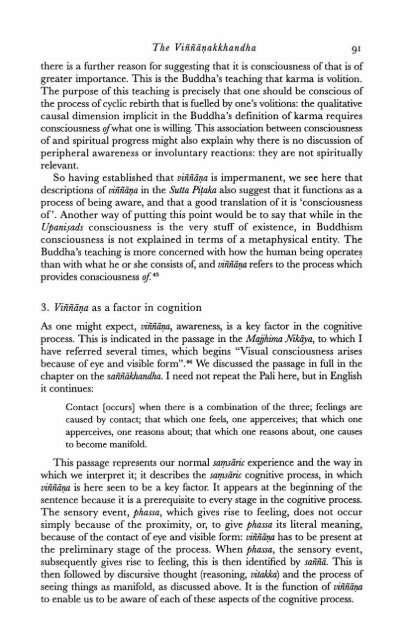Identity and Experience_Hamilton_1996
Identity and Experience_Hamilton_1996
Identity and Experience_Hamilton_1996
Create successful ePaper yourself
Turn your PDF publications into a flip-book with our unique Google optimized e-Paper software.
The Vicfiinakkh<strong>and</strong>ha 91<br />
there is a further reason for suggesting that it is consciousness of that is of<br />
greater importance. This is the Buddha's teaching that karma is volition.<br />
The purpose of this teaching is precisely that one should be conscious of<br />
the process of cyclic rebirth that is fuelled by one's volitions: the qualitative<br />
causal dimension implicit in the Buddha's definition of karma requires<br />
consciousness ofwhat one is willing. This association between consciousness<br />
of <strong>and</strong> spiritual progress might also explain why there is no discussion of<br />
peripheral awareness or involuntary reactions: they are not spiritually<br />
relevant.<br />
So having established that vin"fiina is impermanent, we see here that<br />
descriptions of vin"n"ina in the Sutta Waka also suggest that it functions as a<br />
process of being aware, <strong>and</strong> that a good translation of it is 'consciousness<br />
of'. Another way of putting this point would be to say that while in the<br />
Upani!ads consciousness is the very stuff of existence, in Buddhism<br />
consciousness is not explained in terms of a metaphysical entity. The<br />
Buddha's teaching is more concerned with how the human being operates<br />
than with what he or she consists of, <strong>and</strong> vin"fiiyz refers to the process which<br />
provides consciousness 645<br />
3. VififiZna as a factor in cognition<br />
As one might expect, vin"n"Zp42, awareness, is a key factor in the cognitive<br />
process. This is indicated in the passage in the Majjhima JVZkya, to which I<br />
have referred several times, which begins "Visual consciousness arises<br />
because of eye <strong>and</strong> visible form".46 We discussed the passage in full in the<br />
chapter on the san"n"&hndha. I need not repeat the Pali here, but in English<br />
it continues:<br />
Contact [occurs] when there is a combination of the three; feelings are<br />
caused by contact; that which one feels, one apperceives; that which one<br />
apperceives, one reasons about; that which one reasons about, one causes<br />
to become manifold.<br />
This passage represents our normal savnslZric experience <strong>and</strong> the way in<br />
which we interpret it; it describes the sa~iricognitive process, in which<br />
vififiipz is here seen to be a key factor. It appears at the beginning of the<br />
sentence because it is a prerequisite to every stage in the cognitive process.<br />
The sensory event, phassa, which gives rise to feeling, does not occur<br />
simply because of the proximity, or, to give phassa its literal meaning,<br />
because of the contact of eye <strong>and</strong> visible form: vin"n"a'yz has to be present at<br />
the preliminary stage of the process. When phassa, the sensory event,<br />
subsequently gives rise to feeling, this is then identified by safin"i. This is<br />
then followed by discursive thought (reasoning, vitakka) <strong>and</strong> the process of<br />
seeing things as manifold, as discussed above. It is the function of vin"n"iv<br />
to enable us to be aware of each of these aspects of the cognitive process.


